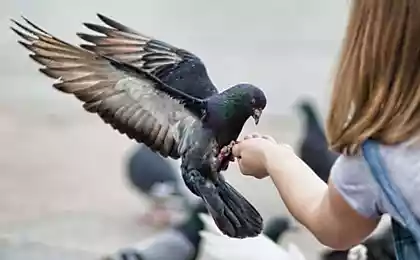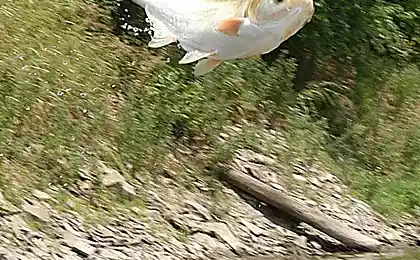723
No need to "save" the chicks!
Similar stories are repeated every summer. Taking a walk in the park, near the cottages in the forest or near the river (the right to enter, delete as appropriate) compassionate, but little versed in biology people are "poor chick" who "lost his parents." Eager to make a good deal, they immediately grab and drag the poor crumbs to his home to feed and surround with care, and then, when it will get stronger - of course, unleash. And then the nightmare begins. "The saved" first chick somehow flatly refuse care offered to him breadcrumbs, in any did not agree to sit in an artificial "nest", which was prepared for him, in a panic rush from the hands and tries to get somewhere in a dark place. Sometimes, after a long agony chick still manages to feed, and even - oh, joy! - After a while it starts to beg for food itself, moving to open her mouth and fluttering wings. But the next day he begins diarrhea, chick weakens and eventually dies. Here it begins oohs, ahs - "what a pity that could not be saved." But the point is that often in such a situation to save the chicks had only themselves "rescue».
Now let's look at the situation from a different angle - So, what really happened? Most songbirds that inhabit our fields and forests, the chicks leave the nest at an age when they still can not fly. The biological significance of this behavior is simple - the predator, who discovered a nest with chicks, inevitably destroy them all. But if the chicks have left the nest and hid alone in the surrounding area - then he may well find one - two, and skip the rest. Consequently, there is a direct sense of the chicks leave the nest as soon as possible. These chicks are called slёtkami. Outside their rather characteristic - they look Kurguzov (tail has not increased) and "greenhorn" (beak surrounded by nestling rollers - they seem to outline open mouth and show parents where to shove brought by food), just the opened pens may not always cover body - but they have already opened his eyes, and they are able to at least sit on a branch, or placed on the ground, leaning on foot. If you are frightened chicks freeze motionless, cork, sometimes even at the same time allow to pull myself together.
If you find somewhere this chick - the most sensible thing you can do - is to go away and not bother him. Parents are sure to find him and feed. If the place seems too dangerous - for example, chick sitting on a park track or on the roadway - you can take it to the nearest bush or sit on a low branch.
letters + 4 photos via dipperman

If this article caught your eye after you've brought the chick home - must be immediately, immediately take him back to where you get it, and release - but only just in the same place, give or take a few meters otherwise it will not find his parents, and he take care of himself yet capable of. Just released in the forest of the chick - to condemn to death. If for some reason return slёtka in nature does not work, it will have his nurse, but after a chick turns into a young bird, release it will no longer be - not mastered under strict parental supervision of all the intricacies of wildlife such fosterling in nature likely doomed to a quick death. The only way to ensure its existence is now - is to leave at home until the end of life.
However, sometimes there are situations when the chicks really get into trouble and need help. Firstly, the socket can be destroyed at an early stage, when the chicks are still not able to properly leave it. It can damage the wind, rain, predators or boys. Finally, it can be lost, one or even both parents. In all cases, take care of artificial feeding chicks - the only way to keep them alive. +
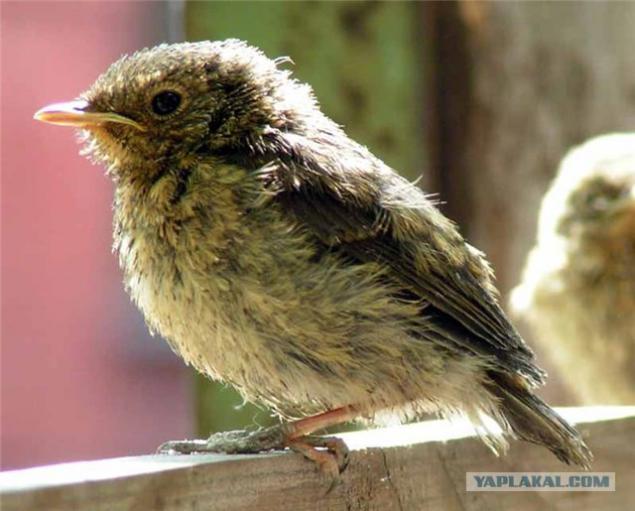
Hand-rearing - it is very difficult and troublesome. Feed it is necessary not less often than once an hour, with a break for 4-6 hours of the night. Chicks of most species of our songbirds can bring up a mixture of hard-boiled egg, cottage cheese and low-fat, finely grated ground beef, although it is very desirable that the composition of the diet consisted of live insects - not large soft caterpillars, mealworms, murevinoe "egg", and so on. P. The composition of the feed be sure to include a multivitamin and mineral supplement. Chicks need water from a pipette. If selected chick refuses to eat for 2-3 hours, it is necessary to forcibly feed, opened his beak and pushing manually write lump soaked in water down his throat. Typically, after 1-2 such feedings chick thinks that to what he begins to open his mouth. Little chicks that have not yet blossomed feathers, it is necessary to heat, maintaining the temperature at 26-28 degrees. For this purpose, suitable rubber hot-water bottle or a jar filled with hot water and wrapped in a clean cloth. Of course, this is only the most general guidelines, but a detailed discussion of the nuances fledging beyond the scope of this article. However, one of these nuances, I think it is worth to stay.
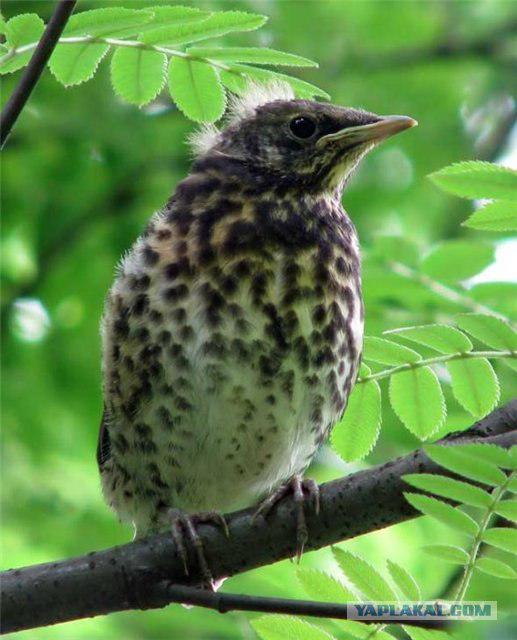
From medium-sized birds native fauna is most often get into trouble chicks swifts. Swift is not a passerine, to which all small songbirds (blackbirds, starlings, warblers, flycatchers, etc.) And his family reign very different than theirs, orders. Parents swifts feed chicks only as long as they are in the nest -, respectively, those in health and sit there until it is fully develop and will not be ready for an independent life. But in the case of starvation (eg during prolonged bad weather) chicks may try to leave the nest prematurely - and then they are doomed since fallen to the ground strizhonka parents seek and will not finish feeding. The fact that even the adult swifts never sit on the ground and almost unable to fly it. So if you find on the ground Swift - make no mistake - this bird is in trouble. Adult Swift, if he is not injured in this situation simply throw in the air, but the young have to grow up to the first "flyable" state. But then it will be possible to release him without fear - because in any case, a young swift, leaving the nest, being developed in the world on their own, without further parental care.
What has been said about the Swifts in no way does not belong to the swallows - despite the resemblance, they do not consist with the swifts in close relationship and behave with their chicks as well as songbirds (which they, unlike swifts, and are ) - that is, finish feeding chicks and train for a long time after they leave the nest. If you are not sure exactly who got in your hands - swift or swallow - look at his foot. We swallow foot arranged the same way as all other songbirds, that is, three fingers look forward, and one - back. And here at Swift all four fingers pointing forward, the foot is more like animals. This swifts are distinguished not only by the swallows, but in general all the other birds. In addition, all of our swallows white belly, and here at Swift is dark, only a small whitish throat spot.
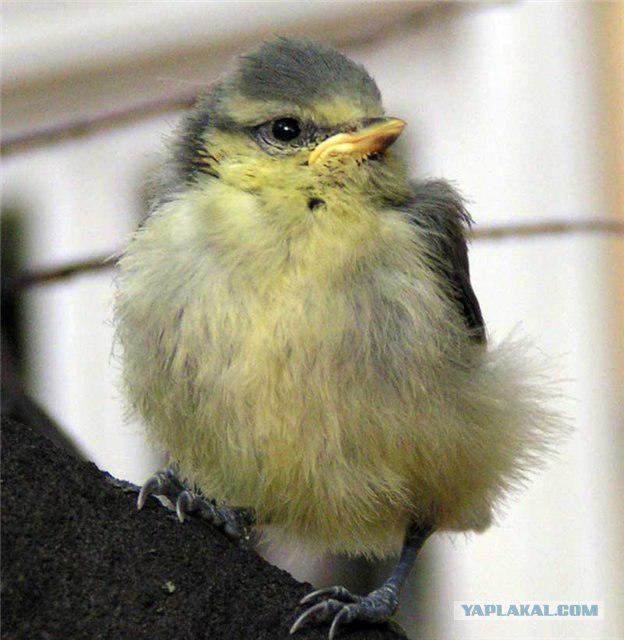
Source:
Now let's look at the situation from a different angle - So, what really happened? Most songbirds that inhabit our fields and forests, the chicks leave the nest at an age when they still can not fly. The biological significance of this behavior is simple - the predator, who discovered a nest with chicks, inevitably destroy them all. But if the chicks have left the nest and hid alone in the surrounding area - then he may well find one - two, and skip the rest. Consequently, there is a direct sense of the chicks leave the nest as soon as possible. These chicks are called slёtkami. Outside their rather characteristic - they look Kurguzov (tail has not increased) and "greenhorn" (beak surrounded by nestling rollers - they seem to outline open mouth and show parents where to shove brought by food), just the opened pens may not always cover body - but they have already opened his eyes, and they are able to at least sit on a branch, or placed on the ground, leaning on foot. If you are frightened chicks freeze motionless, cork, sometimes even at the same time allow to pull myself together.
If you find somewhere this chick - the most sensible thing you can do - is to go away and not bother him. Parents are sure to find him and feed. If the place seems too dangerous - for example, chick sitting on a park track or on the roadway - you can take it to the nearest bush or sit on a low branch.
letters + 4 photos via dipperman

If this article caught your eye after you've brought the chick home - must be immediately, immediately take him back to where you get it, and release - but only just in the same place, give or take a few meters otherwise it will not find his parents, and he take care of himself yet capable of. Just released in the forest of the chick - to condemn to death. If for some reason return slёtka in nature does not work, it will have his nurse, but after a chick turns into a young bird, release it will no longer be - not mastered under strict parental supervision of all the intricacies of wildlife such fosterling in nature likely doomed to a quick death. The only way to ensure its existence is now - is to leave at home until the end of life.
However, sometimes there are situations when the chicks really get into trouble and need help. Firstly, the socket can be destroyed at an early stage, when the chicks are still not able to properly leave it. It can damage the wind, rain, predators or boys. Finally, it can be lost, one or even both parents. In all cases, take care of artificial feeding chicks - the only way to keep them alive. +

Hand-rearing - it is very difficult and troublesome. Feed it is necessary not less often than once an hour, with a break for 4-6 hours of the night. Chicks of most species of our songbirds can bring up a mixture of hard-boiled egg, cottage cheese and low-fat, finely grated ground beef, although it is very desirable that the composition of the diet consisted of live insects - not large soft caterpillars, mealworms, murevinoe "egg", and so on. P. The composition of the feed be sure to include a multivitamin and mineral supplement. Chicks need water from a pipette. If selected chick refuses to eat for 2-3 hours, it is necessary to forcibly feed, opened his beak and pushing manually write lump soaked in water down his throat. Typically, after 1-2 such feedings chick thinks that to what he begins to open his mouth. Little chicks that have not yet blossomed feathers, it is necessary to heat, maintaining the temperature at 26-28 degrees. For this purpose, suitable rubber hot-water bottle or a jar filled with hot water and wrapped in a clean cloth. Of course, this is only the most general guidelines, but a detailed discussion of the nuances fledging beyond the scope of this article. However, one of these nuances, I think it is worth to stay.

From medium-sized birds native fauna is most often get into trouble chicks swifts. Swift is not a passerine, to which all small songbirds (blackbirds, starlings, warblers, flycatchers, etc.) And his family reign very different than theirs, orders. Parents swifts feed chicks only as long as they are in the nest -, respectively, those in health and sit there until it is fully develop and will not be ready for an independent life. But in the case of starvation (eg during prolonged bad weather) chicks may try to leave the nest prematurely - and then they are doomed since fallen to the ground strizhonka parents seek and will not finish feeding. The fact that even the adult swifts never sit on the ground and almost unable to fly it. So if you find on the ground Swift - make no mistake - this bird is in trouble. Adult Swift, if he is not injured in this situation simply throw in the air, but the young have to grow up to the first "flyable" state. But then it will be possible to release him without fear - because in any case, a young swift, leaving the nest, being developed in the world on their own, without further parental care.
What has been said about the Swifts in no way does not belong to the swallows - despite the resemblance, they do not consist with the swifts in close relationship and behave with their chicks as well as songbirds (which they, unlike swifts, and are ) - that is, finish feeding chicks and train for a long time after they leave the nest. If you are not sure exactly who got in your hands - swift or swallow - look at his foot. We swallow foot arranged the same way as all other songbirds, that is, three fingers look forward, and one - back. And here at Swift all four fingers pointing forward, the foot is more like animals. This swifts are distinguished not only by the swallows, but in general all the other birds. In addition, all of our swallows white belly, and here at Swift is dark, only a small whitish throat spot.

Source:



